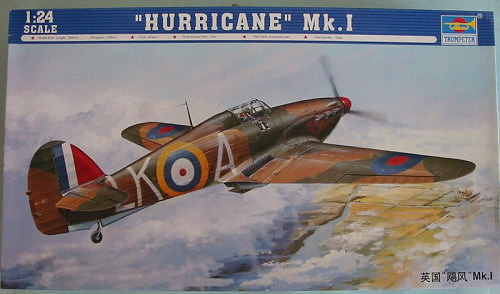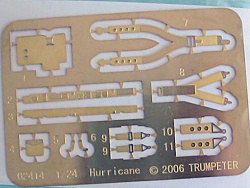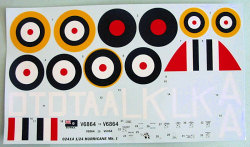
| KIT: | Trumpeter 1/24 Hurricane I |
| KIT #: | ? |
| PRICE: | $139.95 |
| DECALS: | Two options |
| REVIEWER: | Tom Cleaver |
| NOTES: |

| HISTORY |
This is perhaps one of the best accounts of what it was like to fly the Hurricane I in the battle it was born to fight in; it's from the diary of Squadron Leader Ian R. Gleed, OC, 87 Squadron, August 25, 1940:
"I glance back at the 'drome. Twelve dots are climbing behind us. Lucky devils: 213 Squadron: they are after the bombers again. It's a glorious day, the sun beats down on us, the sea looks most inviting - hope I don't have to bathe just yet... Up, up, my two wingmen are crouching forward in their cockpits, their hoods open. I slide mine open - it's too damned stuffy with it shut. My mouth feels hellishly dry - there is a strong sinking feeling in my breast... Once more the sun shines from the sea, its reflection off the surface makes it nearly impossible to look in that direction - the direction the Hun is coming from. I strain my eyes, peering at the sky...
"'Tally-ho!' Christ! There they are!' A weaving, darting mass of dots gradually drift toward us, looking like a cloud of midges on a summer's eve. 'Line astern! Line astern, go!' 'Steady, don't attack too soon...' Here goes, I dive at the nearest circle of '110s - Christ! Look out! A glance behind shows '109s literally falling out of the sky, on top of us! I bank in a steep turn..the '109s overshoot us and climb steeply. Now it's our chance. I straighten out and go for the closest '110. He turns away, I thumb the firing buttons at 250 yards. White puffs flash past the cockpit. A terrific burst of fire from his right engine, got him! A puff of white as the pilot's parachute opens...
"A large chunk of something flashes past my wing...I look back to see the tracers flash by. A '109 is just about on my tail! The stick comes back in my tummy and everything goes away dark. Now an aileron turn downwards - that was a close one! - I miss a '110 by inches, the controls are solid. Where am I? About ten miles off the coast. Hurrah! They've turned away!... Those two Hurricanes ahead have black crosses - '109s! Sights on, I thumb the button - black smoke comes from his engine and I dive away low over the waves. I scream along just over the water...I hurtle past many patches of oil. At last the cliffs loom up! The sea is dead calm, glassy. I'm still alive."
Though the Spitfire gained the glory of the Battle of Britain, it was the tough Hawker Hurricane that won the fight. Three-fifths of the squadrons of RAF's Fighter Command were mounted on Sidney Camm's fighter that summer of 1940. Badly outperformed by the Bf-109E, it was a scandal when reports came out that production Hurricane I's could barely make 305 mph at 10,000 feet - the height at which most combat occurred - and that the airplane could not be flown over 20,000 feet, the altitude from which the Messerschmitts dove out of the sun on their targets. Be that as it may, the rugged, somewhat primitive Hurricane was the more easily-repaired of the two RAF fighters; fully 60 percent of the Hurricanes shot down over England that summer were repaired and returned to operational use during the battle - a fact that Goering's Luftwaffe missed as they confidently predicted that September 15, 1940, would see no RAF fighters over London.
The Hurricane first flew in 1934, as a private venture by Hawker Aircraft. Evolutionary, rather that revolutionary like its stablemate the Spitfire, the Hurricane built on Hawker's long experience with internally-braced metal airframes, covered in fabric. The early Hurricanes still had fabric covered wings, and the fuselage from just aft of the cockpit remained fabric-covered throughout the airplane's life.
What was revolutionary, however, was the armament of eight .303 caliber Browning machine guns in the wings, enough to give a pilot a fair chance of knocking down a bomber with one good burst. The Hurricane was responsible for the destruction of the overwhelming majority of the German bombers lost during the Battle of Britain, as well as close to half the fighters even though it was theoretically outclassed by everything it was flying against.
Outclassed or not, the Hurricane I was there when it was needed, in numbers sufficient to change the outcome of a battle nearly everyone expected Britain to lose. As such, it is a model deserving of a place of distinction in any collection.
| THE KIT |
 Trumpeter’s big Hurricane has been anticipated for some six months now. Given
the company’s history with their other 1/24 kits, only two of which - the
Fw-190D-9 and the Bf-109G-6 - had mistakes that could be completely fixed
(unlike the P-51D, the Zero and the Spitfire), there was a certain level of
trepidation about the kit - what would the faults be?
Trumpeter’s big Hurricane has been anticipated for some six months now. Given
the company’s history with their other 1/24 kits, only two of which - the
Fw-190D-9 and the Bf-109G-6 - had mistakes that could be completely fixed
(unlike the P-51D, the Zero and the Spitfire), there was a certain level of
trepidation about the kit - what would the faults be?
Well, now that the box has been opened, the only obvious faults are that the kit
comes with a prop for the Hurricane II - which makes a certain amount of sense
since the other announced release is a Hurricane IID - and the lack of the
circular core in the radiator. The latter is something 90 percent of those who
look at the completed model will miss, and the former is something easily solved
with a sanding stick and ten minutes of the modeler’s time.
In
fact, this might be the best Hurricane kit released. The fabric surface detail
of the ailerons, vertical fin and rudder, and the horizontal stabilizer and
elevators, is very nicely restrained, while the fabric detail on the rear
fuselage looks very close to what I see when I look at the 1:1 Hurricane out at
Planes of Fame. Yes, there  are
engraved rivets, but they are very restrained, like the SBD Dauntless and the
Me-262 kits, and the surface looks “accurate” to me in the same way the SBD
kit’s surface detail does when compared to the real thing.
are
engraved rivets, but they are very restrained, like the SBD Dauntless and the
Me-262 kits, and the surface looks “accurate” to me in the same way the SBD
kit’s surface detail does when compared to the real thing.
The
cockpit is nicely detailed, and a photoetched seatbelt harness is provided - a
good thing since there are no 1/24 aftermarket seatbelts I am aware of. This is
the only Hurricane kit that gets the area of the cockpit underneath the canopy
at the immediate rear correct.
The Merlin engine provides a good basis for anyone who wants to super-detail the engine. The lower side panels are provided in clear plastic for those who want to display the engine.
The decals suck, but that’s a given with Trumpeter. The red and blue is much too bright, and the squadron codes for Ian Gleed’s “Felix” of 87 Squadron and Robert Stanford-Tuck’s airplane from 257 Squadron are done in white, rather than the correct medium sea grey. Fortunately, there are some 1/24 decal sheets available - most prominently two sheets from Techmod for Hurricanes flown by 303 and 306 Squadrons in the Battle of Britain - that get the colors right.
| CONCLUSIONS |
Overall, this kit looks no more difficult to assemble than the 1/48 Hasegawa Hurricanes, with the result being a big, accurate model of one of the most famous airplanes in history. I am not that interested in this scale, with the only other 1/24 kit I have ever built being the Trumpeter Fw-190D-9, but this big Hurricane is going to the top of the to-do pile. Now if they’d just do it this good in 1/32...
Buy in confidence.
Thanks to Stevens International for the review kit.
If you would like your product reviewed fairly and quickly by a site that has over 350,000 visitors a month, please contact me or see other details in the Note to Contributors.